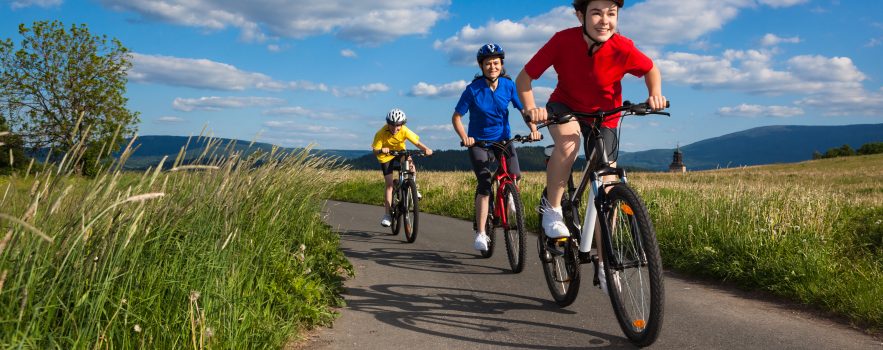New study finds overall physical activity is increased by proximity to routes.
The provision of new, high-quality, traffic-free cycling and walking routes in local communities has encouraged more people to get about by foot and by bike, according to a new study published today in the American Journal of Public Health.
Two years after new routes were developed by charity Sustrans with local authority partners, people living nearby increased their total levels of physical activity, compared to those living further away.
People living 1km (0.6 miles) from the new routes had increased their time spent walking and cycling by an average of 45 minutes per week more than those living 4km (2.5 miles) away.
This could make a substantial contribution to helping people achieve the two and a half hours of physical activity per week recommended by health experts.
Research led by the MRC Epidemiology Unit at the University of Cambridge, on behalf of the iConnect consortium, surveyed adults living in three communities before and after they benefited from a national initiative led by the sustainable transport charity Sustrans, and funded by the Big Lottery Fund, to build or improve walking and cycling routes at 84 sites around the UK.
Crucially, there was no evidence that the gains in walking and cycling were offset by reductions in other forms of physical activity. This suggests that the new routes have encouraged local people to become more active overall. The benefits were equally spread between men and women and between adults of different ages and social groups. However, people without access to a car were more likely to increase their activity levels than those who had a car.
Dr Anna Goodman, lecturer at the London School of Hygiene and Tropical Medicine and lead author of the paper, said:
“These findings support the case for changing the environment to promote physical activity by making walking and cycling safer, more convenient and more attractive. The fact that we showed an increase in overall levels of physical activity is very important, and shows that interventions of this sort can play a part in wider public health efforts to prevent diabetes, heart disease and other chronic conditions.”
Dr David Ogilvie of the MRC Epidemiology Unit at the University of Cambridge, who led the study, added:
Although it may seem intuitive that improving facilities for walking and cycling will help make the population more active, this has rarely been tested in practice, and most of the existing studies have been done in other parts of the world. This is one of the first studies to show that changing the environment to support walking and cycling in the UK can have measurable benefits for public health.
While the initiative is an ambitious programme involving many communities around the country, the individual projects involved relatively small changes to the route networks in those towns and cities and we did not see a significant effect on activity until two-year follow-up. It can take time for the benefits of this sort of investment to be fully realised.”
Malcolm Shepherd, Chief Executive of charity Sustrans who implemented the three projects, said: “It’s clear that when good quality infrastructure exists people use it. Our experience from co-ordinating the National Cycle Network, which saw an amazing three quarters of a billion (849,000,000) journeys in 2013, 7% more than the year before, has shown us this over and over again.
With a physical inactivity crisis and traffic jams clogging our towns and cities the case has never been stronger for governments to guarantee dedicated funding for quality walking and cycling routes for everyone.”
The three communities studied were in Cardiff, where the centrepiece of the project was a new traffic-free bridge across Cardiff Bay; Kenilworth in Warwickshire, where a new traffic-free bridge was built across a busy trunk road to link the town to a rural greenway; and Southampton, where a new boardwalk was built along the shore of the tidal River Itchen. All of these new crossings then linked into extensive networks of routes.
Notes:
The full paper is published in the American Journal of Public Health, 17/07/2014
Goodman A, Sahlqvist S, Ogilvie D; on behalf of the iConnect Consortium. “New Walking and Cycling Routes and Increased Physical Activity: One- and 2-Year Findings From the UK iConnect Study.” Am J Public Health. 2014 Jul 17:e1-e9.
• Sustrans, with funding from the Big Lottery Fund, worked with local authorities and many other partners to transform local travel in 84 communities around the UK by creating new crossings and bridges to overcome barriers such as busy roads, rivers and railways, giving people easier and healthier access to their schools, shops, parks and countryside (www.lotterygoodcauses.org.uk/project/sustrans-connect2).
• The iConnect (Impact of COnstructing Non-motorised Networks and Evaluating Changes in Travel) study aimed to measure and evaluate the changes in travel, physical activity and carbon emissions related to the projects in three of the communities. The iConnect consortium involves independent researchers from the University of Bristol, the MRC Epidemiology Unit at the University of Cambridge, the University of Edinburgh, the University of East Anglia, Loughborough University, the University of Oxford, the University of Southampton and the University of the West of England, Bristol (www.iconnect.ac.uk).
• The results reported in this study are based on a postal survey of a random sample of adults living in Cardiff, Kenilworth and Southampton. 1796 adults completed questionnaires about their physical activity in the past week before the construction of the routes and again one year later; 1465 completed questionnaires after two years.
• The iConnect study was funded by the UK Engineering and Physical Sciences Research Council (EPSRC). Anna Goodman’s contribution to the study is funded by a National Institute of Health Research (NIHR) post-doctoral fellowship. The views presented in the paper and in this press release are those of the study authors, and do not necessarily reflect those of EPSRC, NIHR or other funders.

 MRC Epidemiology Unit
MRC Epidemiology Unit